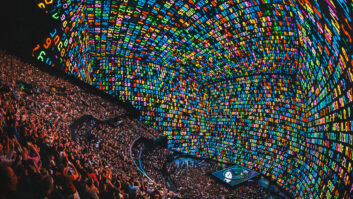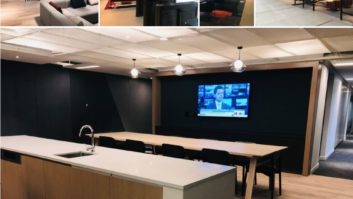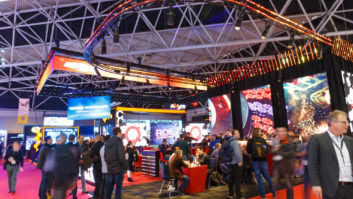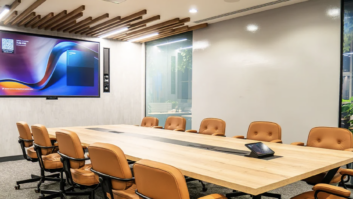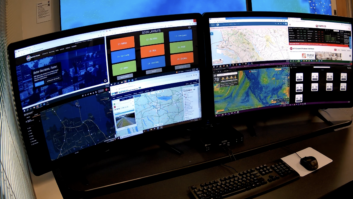Systems integration (SI) has changed and developed considerably in the last 20-plus years. The 21st century brought not just more digital technologies to work with and integrate into installations but also different services customers expect from integrators. There are also new and varied market areas that have taken SIs beyond traditional AV disciplines, the most obvious being conference and meeting rooms.

These were a source of steady work for many years but received a boost following the Covid work-from-home trend. But, even though the shift to hybrid working created new business for many integrators – going someway to make up for the loss of event and other installation projects when things were still far from returning to normal – the after-effects of Covid, combined with the ramifications of the UK leaving the European Union (EU), are still being felt.
STEADY GROWTH
“We are still recovering from Brexit and the pandemic but there has been a steady growth across all the sectors we deal in,” comments Steve Clarke, technical director of the ITSL Group. “It has become apparent that most businesses are looking more towards cost-effective and sustainable solutions instead of the lavish boardrooms of yesteryear.”
In particular, video conferencing has evolved due to the new style PC-driven systems as embodied by Microsoft Teams Room (MTR), which Steve Hudson, chief operating officer of Project Audio Visual, says are now a major component of integration business – adding that they are also part of the relatively recent trend for installers to work in particular business sectors.
“If we go back 20 years all the companies did a bit of everything,” he says. “But over the last five to 10 years everyone found a niche and began working in certain areas. Coming out of Covid we were on the Teams team and also had been doing a lot with Microsoft Teams before that while doing a lot of other stuff as well, including digital signage, high-level home cinema and hospitality. We are now finding those sectors coming back and growing, with our big markets tending to be corporates, councils and retail.”
From the perspective of one of the big international SI groups, Kinly, chief executive Tom Martin says the global market is experiencing “significant growth” driven by demand across various sectors. “There’s no one sector necessarily [where this is happening], but corporate, education and entertainment are all growing quite nicely and progressively,” he says. “There are differences between sectors and geographies. Asia/Asia-Pacific is growing at a faster rate than everywhere else in terms of technology adoption, the rise in remote working and e-learning practices.”
Kinly is currently focusing on the corporate, enterprise and education sectors but Martin says it is also seeing growth in “complementary areas”, where traditional SI is coming closer to the relatively new area of ITSI (Information Technology Systems Integration). “These are new types of customers looking for collaboration solutions and maybe moving towards some specialist and niche providers more than previously during the pandemic,” he comments. “We’re also seeing massive growth around events, including staging and rental business. That’s really [started] coming back since the pandemic, with major investment in AV solutions to create a different type of user experience.”
NEW DISCIPLINES
David Corker, technical sales director of Strive AV, agrees that the integration business is expanding due to the incorporation of other disciplines into traditional AV projects. “The SI market is growing exponentially, specifically with IT integrators now branching out to become IT/AV solution providers,” he says. “This is due to AV equipment becoming a standard requirement in all sectors. We’ve been seeing office fit-out, IT and even office supply companies offering AV equipment and services.”
The type of project Strive AV and other integrators are now taking on has changed substantially in the last four years, with, as Corker observes, network-based AV being a daily offering. “Where previously audio and video systems were all analogue and point-to-point, these are now being introduced directly on to the client’s main LAN with separation into dedicated VLAN for AV control and Dante audio over IP [AoIP],” he says. “Almost every piece of AV kit can be networked, for example traditional background audio systems in cafés, or large open areas in buildings that once would have been 100V line systems and across multiple floors, which are being reviewed with network-based loudspeakers discussed instead.”
Steve Blyth, founder and chief executive of Engage Works, is seeing “substantial growth” in particular for hybrid workplaces and live and cultural venues. “These market areas are increasingly adopting innovative AV solutions to enhance engagement and immersive experiences,” he comments.
“The nature of our projects has changed significantly in recent years. While we continue to deliver on traditional projects, we are increasingly involved in new areas and regions that were previously outside our scope. We constantly explore and integrate cutting-edge technologies to stay ahead in what is a dynamic field.”
NEW MARKETS
At Tateside AV, technical director Jack Cornish comments that while the company is still working primarily in the established integration areas of corporate, enterprise, retail and hospitality, a few new markets have opened up in recent years, “We’ve had quite a few padel courts and multi-use venues that we’ve worked on recently,” he says. “Padel is a more social racquet sport than tennis. You wouldn’t put loudspeakers round a tennis court but for some reason these new venues want background music in there.”

Cornish agrees that the role of the SI has been shifting from being solely an installer, to working more closely with the client to provide exactly what they need or want. “Like any company we try to stay ahead of trends and at least be trying to pass those new ideas on to clients,” he says. “I see ourselves not being consultants but sharing more knowledge about technologies of which people may not be aware. We’re becoming more specialised in why something is not performing as it should, looking into whether it’s an environmental issue, for example. We’re investing in tools to resolve that and come up with solutions for clients. Acoustics has been a big part of this because it goes hand-in-hand with an AV offering.”
Steve Clarke does not think the role of the SI has changed “on the surface”, although he notes that companies such as ITSL are becoming more involved earlier on in projects. “This is because AV has been noticed as an important service, much like data,” he says. On the other hand, Blyth sees the role of the SI as having evolved considerably: “We spend more time familiarising our clients with the advantages of professional technology, the complexity involved in delivering high-quality, reliable systems and how to future-proof them. The market has become more user experience focused, which means the role of SI now includes more consultative elements, guiding clients through the nuances of AV integration.”
MARKET TRENDS
David Corker agrees that the SI business is always changing and adapting to market trends. “One area of substantial change is the requirement for a higher level of configuration and commissioning of AV equipment,” he says. “At least 70 percent of hardware now requires configuring on-site to ensure it works as required for that specific space.”
Tom Martin is of the opinion that the SI’s role has changed “quite significantly” and not just in the last few years. “That’s not necessarily pre- or post-pandemic but in the last five to 10 years,” he says. “But it is accelerating now. AV is no longer a tool that is simply used to present and communicate information. It is integrated much more into a customer’s entire workflow. SIs need to understand this and work with the customers to develop end-to-end workflows to ensure solutions are supporting productivity. Things are becoming significantly more integrated and therefore the role of the AV SI has, I think, changed completely.”
Steve Hudson picks up on what he views as the amount of service Project Audio Visual, like other SIs, is now providing to its customers. “We are finding more clients don’t just want an install, they want it managed as well, which is a part of the business that is growing very quickly for us,” he says. “In terms of AV as a Service [AVaaS] I think we’ve always done it. However, it is more prevalent now where a lot of companies are looking at CapEx [capital expenditures] versus OpEx [operating expenses] and seeing which is a better model for them. We’re wrapping everything into a package, not just the equipment, but the service as well.”
MAJOR CONSIDERATION
AVaaS has become a major consideration in the last few years but it is not quite the innovation people might think. “It has been around for years,” says David Corker. “At Strive AV we have been offering leasing to end users for over 15 years. Leasing equipment is very much affordable and allows customers to align their technologies and AV spend every three to five years, or more, dependant on their rolling refresh programme. Now with more subscription-based solutions from manufacturers, this makes things much easier.”
Tom Martin feels that while AVaaS is established as both a revenue stream and a way of consuming services for a lot of companies, it is something Kinly sees more requests for rather than actual implementation. “As a service it is a growing area and a lot of companies we’re dealing with are used to consuming services like that,” he comments. “If you have an IT network infrastructure as a service, why not AV? I think it’s a natural progression.”
Last year Tateside launched a Managed Services division offering AVaaS. Jack Cornish views the ‘as a service’ element as “an opportunity”, with clients who are looking for finance deals and rapid maintenance as part of it. “The whole cost can be done on a monthly basis, which is quite popular on sites,” he says. “I think there’s definitely more of an appreciation for AVaaS and people are valuing having a professional who they can call when they have issues. I think that’s where we can be more valuable as an industry, with the specialisms we all have as our USP.”
Not every SI is following the AVaaS trend, however, although this does not mean the idea of offering more services has been rejected completely. “While AVaaS isn’t a primary focus for Engage Works, it’s a concept closely tied to our work at our partner company, Flux Innovation,” says Steve Blyth. “This represents a shift towards ‘Innovation as a Service’, providing more flexible, scalable technology solutions that clients can adapt to evolving needs. For SIs, it means creating service models that offer ongoing value and support rather than just one-time installations.”
CONTINUING CONSOLIDATION
Another major talking point in the SI sector is the continuing consolidation of the market, with big groups getting ever bigger through the acquisition of other companies. A recent example is AVI-SPL buying ICAP Global, an integration and distribution company with offices in Argentina, Spain, Chile, Colombia and Peru. (AVI-SPL was approached to participate in this roundtable but declined on the grounds of time.)

More recently than that, Project Audio Visual has been bought by AVPM Group and will work alongside AV and IT retailers AV Partsmaster and IT Partsmaster. Steve Hudson says these pooled resources will enable Project Audio Visual, which will retain its identity, to take on larger projects and expand its reach.
“There is still a place for smaller specialist companies out there,” Hudson comments. “The reason we were attracted to AVPM was the fact that we can still be working in the market but now with a lot more finance and clout behind us. When we’ve gone for bigger jobs in the past, potential clients have looked at us and not been sure if we could handle it financially. Now we can.”
Steve Clarke agrees that smaller, specialist SI companies continue to be an integral component of the overall market alongside the big groups. “As a mid-sized integrator, ITSL Group pride itself on being adaptable either way,” he says. “We still undertake sub-£1000 quotes and are quite happy with projects over the £1 million mark. We try to provide the personal service you would expect from small ‘family’ style business but have the staff, knowledge and expertise to compete with the AV giants.”
MORE QUESTIONS
Tom Martin answers the question with further questions, starting with why so many companies are acquiring each other. “Is it to create more scale or is it because they’re wanting to encroach on another market? Or is it because they’re looking for a uniqueness within the company that they buy?,” he ponders.
“The real question is who’s buying who and why? It definitely has an effect on the market and I think what you’re seeing is a lot of smaller AV and UCC [unified communications and collaboration] businesses consolidating with IT SIs or other kind of strategically aligned businesses.
“This is to evolve a wider service offering into UCC and immersive technology, maybe giving access to a customer base which they hadn’t previously had. There is also the issue of global reach, which smaller companies are not able to handle in a way customers expect without international offices, which is why some of these smaller companies are consolidating because they won’t survive on their own.”
SI is led both by what the clients are asking for and what technology can offer both them and the integrators themselves. It comes as no surprise that artificial intelligence (AI) is at the forefront of SIs’ minds right now, at it is for most people in general. “AI, the Internet of Things [IoT] and advanced analytics are revolutionising AV integration across different sectors,” observes Steve Blyth. “AI-powered solutions create more intuitive and responsive systems, while IoT devices provide enhanced connectivity and control.”
Tom Martin agrees, adding that the adoption of AI into existing technologies and products will create “different and better user experiences”, while pointing out it is already present in digital signal processors and cameras for framing.
Previous buzz-wordy technologies – such as LED walls and virtual production – are now established in AV but, as Steve Clarke notes, continue to influence the way installations are designed.

“We have started seeing a huge uptick in direct view LED requests and custom video solutions across all sectors,” he says. “As the price for this comes down it will compete directly with Large Format Displays and even high-end projection. In a similar way, virtual production has moved away from specialist studios to being affordable for smaller or even personal venues.”
As for the future of the SI market, the contributors to this roundtable seem confident, albeit aware it is one that is susceptible to sudden outside forces, as with the pandemic. “There’s no secret that the start of this year was quite bad for a lot of people,” says Steve Hudson. “But we’re seeing a big bounce-back coming and are very excited. AV still has a lot of growth in the long-term but the biggest issue now is the IT channel trying to take as big a chunk out of it as they can.”
Tom Martin comments that there are still problems, with the border and customs checks imposed by Brexit bringing additional admin work and making logistics more time-consuming. “But there is significant growth on a global level,” he adds. “We’re going to continue leveraging new technologies and finding new revenue streams, which the AV industry is good at. It’s a competitive market but it’s still growing very quickly. I’m pretty confident it’s going in the right direction.”
Which is the general feeling of the panel, something that shows–- however unscientifically – that systems integration is nothing if not resilient and adaptable.
